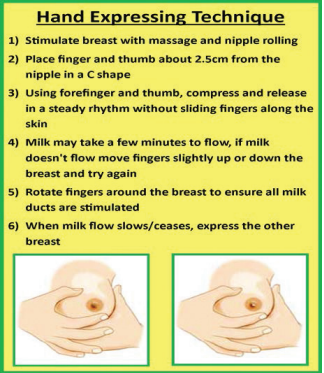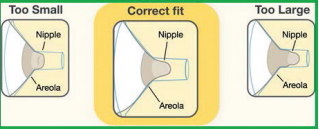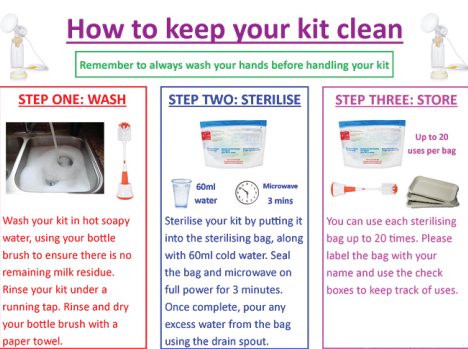Download and print as a PDF (942kB pdf)
On this page
Dear Parents
Congratulations on your baby’s arrival. At UHSussex we are committed to supporting breastfeeding, and recognise that this is particularly important for sick and premature babies.
We will assist you to hand express your milk before, during or after labour and use a breast pump if needed. Ideally we would like your baby to have their first feed within 2 hours of birth. It is perfectly normal to only get small amounts at first, and it may take a few days for your milk to come in. Any milk you can provide will be beneficial for your baby.
Whatever your long term feeding choice we do ask that while your baby is in the neonatal unit that you express your breast milk, as it is the only milk which helps to protect a premature baby’s delicate gut from developing a serious condition that can
cause a baby to become very sick.
Your milk will be given as medicine with every dose providing antibodies and goodness to help your baby get better, stay well, and grow.
Babies learn to feed in their own time but practice makes perfect.
Colostrum
Your first milk is called colostrum.
Your body starts producing colostrum around 16 weeks of pregnancy so if your baby is born early you will have colostrum there. Please ask for our help in expressing it.
• Comes in small, viscous quantities, sometimes just a few drops.
• Helps to protect your baby from infections and build a strong immune system.
• Primes and coats your baby’s stomach and intestines to help prevent germs from causing illness.
• Helps regulate the baby’s blood glucose.
• Provides the perfect blend of nutrients for your baby’s brain, eyes, and heart.
• It is complete nutrition that is easy for your baby’s stomach to digest. Combining hand expressing and using the breast pump will give you the best chance of achieving a full milk supply.
Hand expressing is the best way to collect your colostrum but the breast pump can stimulate your breasts to produce more colostrum and bring in your milk. No amount is too small; each drop is beneficial to your baby’s health.
If your baby is not able to breastfeed or if you are separated from
your baby, you will need to express 8-10 times in each 24 hour
period from birth. This includes in the night to ensure that you
reach your maximum milk making potential. To optimise milk
production do not leave gaps of more than 4 hours during the
day and 5 hours during the night. Regular expressions are the key
to success. Milk is made on a supply/demand basis. The more you
stimulate and remove, the more you will produce.
Progressing to suck feeds
• Observe your baby for readiness to feed and feeding cues.
• Watch these videos demonstrating positioning your baby for breastfeeding.
• Learn how to give your baby milk by nasogastric tube while they are learning to feed responsively.
• Premature babies learn to feed first by ‘non-nutritive’ sucking on a dummy or on a recently expressed breast. Express before skin to skin cuddles and let then try from around 28 weeks gestation.
Babies learn to feed in their own time but practice makes perfect.
Hand expressing
Always wash your hands before collecting milk.
You can start collecting colostrum for your baby from 36 weeks gestation, once you have been induced or 48 hours before your birth is scheduled.
Watch the video on hand expressing to learn more.
Hand expressing is the most effective way to collect colostrum. However combining hand expressing with using a breast pump after birth will stimulate and maximise your milk production. Some research supports using the pump after hand expressing as early as 2 hours after giving birth. Speak with your neonatal nurse about timing. All women who give birth prematurely will be supported to start using the pump alongside hand expressing on day 1.
Label your syringe with your name, plus the date and time that you expressed and give it to your nurse to be given directly to your baby.

Breast massage techniques
Gentle breast massage helps your milk to flow. Massage your breasts for a minute or so before expressing and then hand express a small amount of milk onto the nipple tip before applying the pump funnels. Massage should feel comfortable so remember to be gentle.
If your milk is slow try:
• Applying a warm compress, such as a flannel or towel to your breast.
• Stroking your breast with gentle feather-like movements.
• Massaging your breast with a hand action that rolls the knuckles downwards over the breast, beginning at the top of the breast and working towards the areola, gradually going over the whole breast.
• Stroking the area under the nipple and areola with flat hands in an upward movement.
• Asking your partner or a friend to massage your back before you express.
Electric breast pump
Using a hospital grade electric breast pump can fire up your milk making cells and maximises your long term milk production. Pump use is often started after hand expressing around day 1. However some women may wish to start earlier, soon after birth. Hand expressing is still the best way to collect colostrum in the first few days.
• Expressing both breasts at the same time helps maximise your milk production.
• Breast massage helps to stimulate your milk flow before pumping and ensures your breasts are fully drained at the end of pumping.
• Use the gentle and stimulating INITIATE or STIMULATION setting until your milks transitions or until day 6 after birth. This will run for 15 minutes and turn itself off on some pumps and others you need to time it.
• Once your colostrum transitions to breast milk (or day 6 after birth even if your milk has not transitioned), use the MAINTAIN setting to drain your breast effectively. Express until the flow of milk ceases plus 2 minutes or 15 to 20 minutes if there is no flow.
Comfort
Pumping should be comfortable. If you feel any discomfort check:
- Your funnels are the correct size. Check our guide below.
- The vacuum is not set too high. Increase the vacuum on the pump slowly until it starts to feel a bit uncomfortable and then reduce it by 2.
- Your nipple is central to the funnel.
- You do not remove the funnel while the pump is running.
- Your bra is comfortable with no under-wires.

For hands free pumping try adapting an old bra by cutting slits along the seams in the end of the cups just large enough to slip the narrow point of the funnel through so the funnel sits snugly and the vacuum is maintained.
Milk flow and volumes
• Your colostrum will transition to milk from day 2 to 3 but can be delayed up to a week following difficult births.
• Once your colostrum transitions to milk it should start flowing within a couple of minutes of starting the pump.
• You will see an increase in volume day by day until you are expressing up to 750mls by 2 to 3 weeks.
If your milk is slow or your volumes are low:
- Massage and hand expressing some milk onto the nipple tip before starting the pump.
- Gently compress (squeeze) your breast while you express.
- Expressing by the cot-side or looking at a photograph and/or smelling something with your baby’s scent on it.
- Regular skin to skin cuddles with baby.
- Expressing immediately after close contact with your baby.
- Cluster/power pumping, see below.
- Watch hands on pumping video
Cluster pumping/power pumping
One hour option add one in every day
Pump 20 mins
Rest 10 mins
Pump 10 mins
Rest 10 mins
Pump 10 mins
Four hour option
Express for 15 minutes and then take a 30 minute break. Repeat for the full 4 hours. Do this for 3 consecutive days for best effect.
Expressing frequency and times
Expressing 8 to 10 times in 24 hours, including once in the night.
Expressions do not have to be done to a particular routine; rather they should fit in with your daily schedule. It is beneficial to ‘surprise’ the breasts by not always pumping at the same times each day. Leave no longer than 5 hours between expressions at night, and no longer than 4 hours in the day. If you do choose to have a 4 to 6 hour gap between expressions, you will then need to cluster your expressions to fit in the recommended daily amount. Expressing at night between 1am and 5am is hormonally very important for milk production.
Example routine:
- Before you go to bed.
- Once in the night between 1am and 5am.
- As soon as you wake up.
- After breakfast.
- After skin to skin cuddles with baby.
- After lunch.
- After an afternoon nap.
- After dinner.
- While relaxing in the evening.
Keep a log of your expressing times and your 24 hour volumes to discuss with your midwife each day. We can help troubleshoot problems quickly.

Pumping log: at the end of the leaflet is a pumping log form for you to complete. Please print off the PDF version to obtain the form.
Thank you to Oxford University Hospitals and Ashford and St Peters Hospitals for sharing information for this leaflet.
This leaflet is intended for patients receiving care in Brighton & Hove or Haywards Heath.
The information in this leaflet is for guidance purposes only and is in no way intended to replace professional clinical advice by a qualified practitioner.